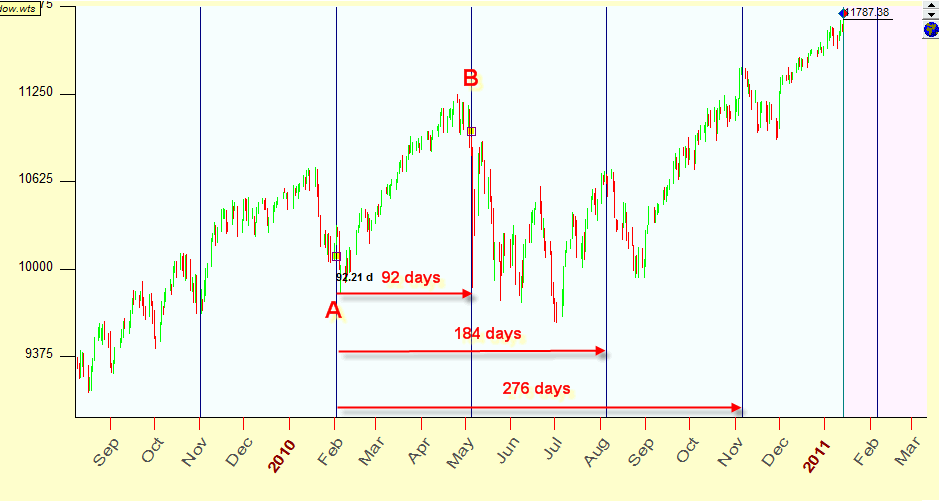
Stock market steps
the description of "Smart steps" module in Timing Solution
written by Sergey Tarassov
If you would like to formulate in a few words the general idea of cyclical analysis, it will sound something like this: "The history repeats itself". This is the core idea of any stock market timing technique - we believe that the market history repeats itself and accordingly we prolong into the future the patterns that worked before.
I will demonstrate this idea with one example (this is not a trading advice!):

For this example I have downloaded Dow Jones Industrial index data for the last 4 years.
Let's consider here two important events: A - a bottom in the beginning of February 2010, and B - a huge drop in the beginning of May 2010. The distance between these two points is 92 calendar days. As we have assumed that the market history repeats itself, we prolong this 92-days cycle into the future. Therefore we watch other dates related to the event A. The next date is 184 days (2x92) away from the point A; this date falls on the beginning of August 2010 which coincides with market top before August correction. In the same manner we watch the triple cycle - the beginning of November 2010. This coincidence gives us a confidence that this 92-days cycle is makes some sense and is suitable to be used to forecast Dow. But - is this just a pure occasional coincidence or a real fact? How do we know? In this article I will try to answer this question.
The main issue here is to find the most informative/efficient/forecasting interval/cycle that can be used to forecast the stock market behavior. How to do that? I guarantee you that you can take ANY cycle with any period - like 36, 129, 321 or whatever is the number of days cycle - and find impressive examples that confirm "workability" of those cycles, His Majesty Chaos likes to play such tricks to us, "Give me any cycle and I will give you a good example" (as the example above) - it is what Chaos can say to you.
Before going further with the explanation, some definitions should be discussed.
Cycles metrics
How do we measure a cycle's period? We can measure it in calendar days or in trading days. We can also work with cycles that are based on planetary movements; these cycles are more interesting for us because they are irregular, and the irregularity is the most obvious feature of the stock market behavior.
Look at this example:
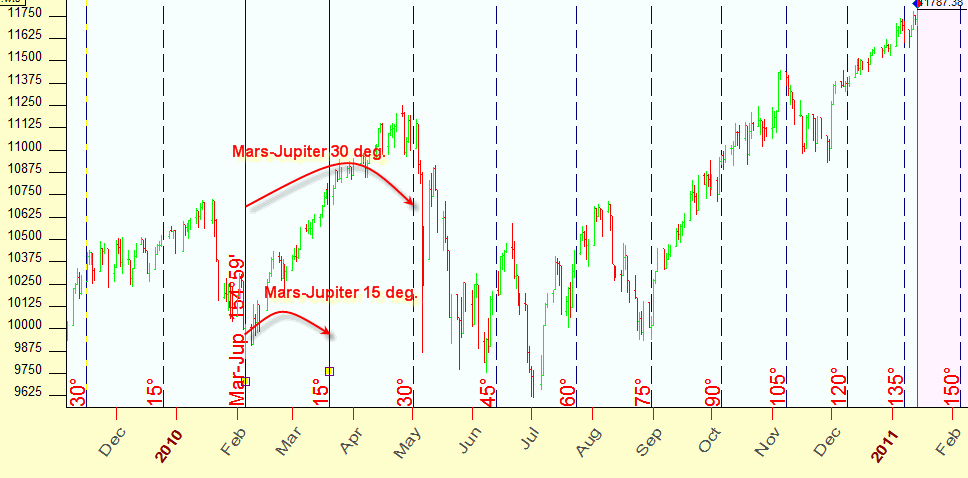
Here we have considered the moments when the angle between Mars and Jupiter in heliocentric coordinates is changing for 15 degrees. In other words, we assume here that important events on the market happen when the angle separation between Mars and Jupiter heliocentric changes on 15 degrees. Mathematically speaking we deal here with the special time - we can measure the time in calendar days, in trading days or in values of the angle separation between two planets (or in values of changes in the planetary position).
For example, the distance between two important turning points of the latest Great Financial Crisis - the bottom in the beginning of March 2009 and top in May 2010 - is:
a) 416 calendar days
b) 260 trading days
c) 183 deg 40 minutes Mars-Uranus heliocentric angle separation:
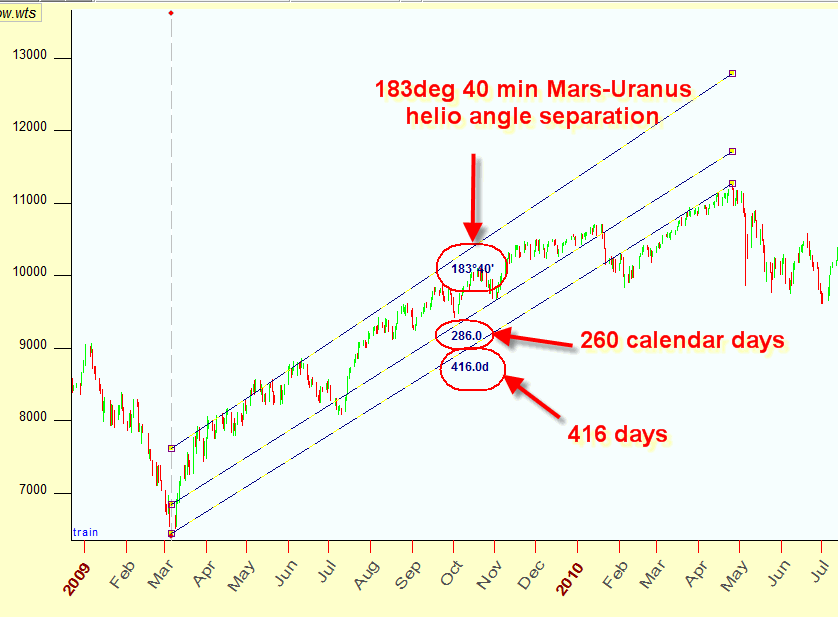
The method of measuring cycles periods is called metrics. Any of these time metrics can be used for timing, as well as lots of planetary combinations that can be used to measure time.
Spectrogram
As I said above, the most important question is finding the right cycle, i.e. we need to find the right metric and the right period. We need to have some formal approach and criteria otherwise we will be drawn in the sea of ideas. We need to understand why 117 cycle is stronger than 150 days cycle (as an example).. The methods to reveal cycles were developed by Arthur Scshuster in 1898 and improved significantly in 20th century. I prefer the method called "Spectrogram". This is a spectrogram for Dow Jones Industrial Index:
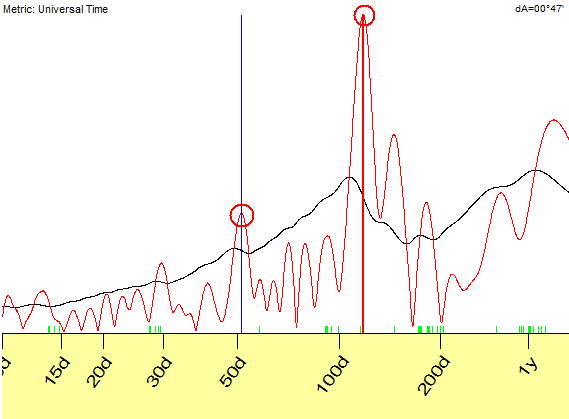
This diagram shows the accumulated energy of each cycle (so called spectral density). The peaks of the diagram correspond to the most powerful cycles. Here the program has revealed 51 and 117-days cycles. Knowing the period of these cycles, we can use them for timing. As an example, below you can see equidistant lines with the step equal to 117 days and the starting point in March, 2009:
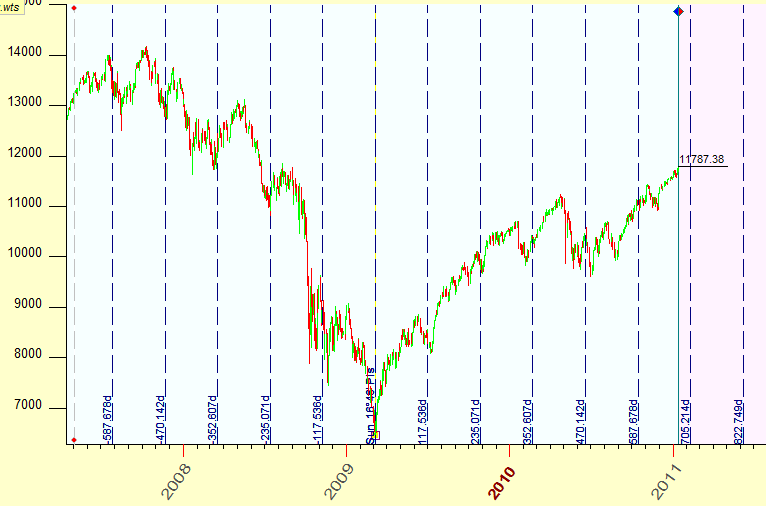
As you see, many of these lines indicate important turning points. Thus our assumption of the workability of the 117-days cycle is confirmed by the historical data.
The beauty of this technique is a union of precise mathematical approach (a spectrogram that allows to reveal cycles) and a non-formal charting tool that allows to vary the starting point manually. This is important: the science provides us the general frame of our research while we apply this technology for real stock market conditions.
Let us look at another influential player of this game - 57-days cycle:
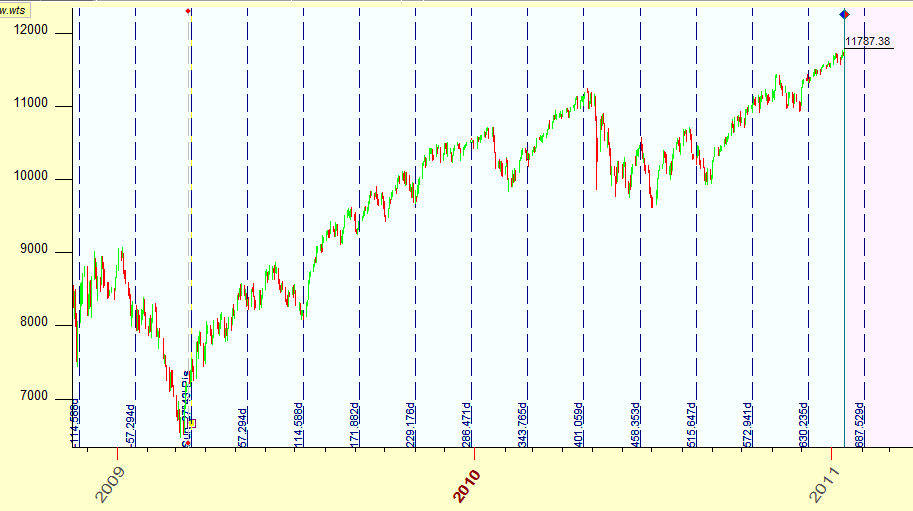
Of course these results are not ideal, but in financial mathematics there are no ideal models. We simply have to accept this fact and try to get a maximum of the information from the price chart. Spectrum analysis guarantees you that this is the best possible solution.
To get the advantage of both cycles, we can draw these cycles together. Here the red stripes correspond to 57-days cycle, blue - to 117-days cycle, and the starting point is in March 2009:
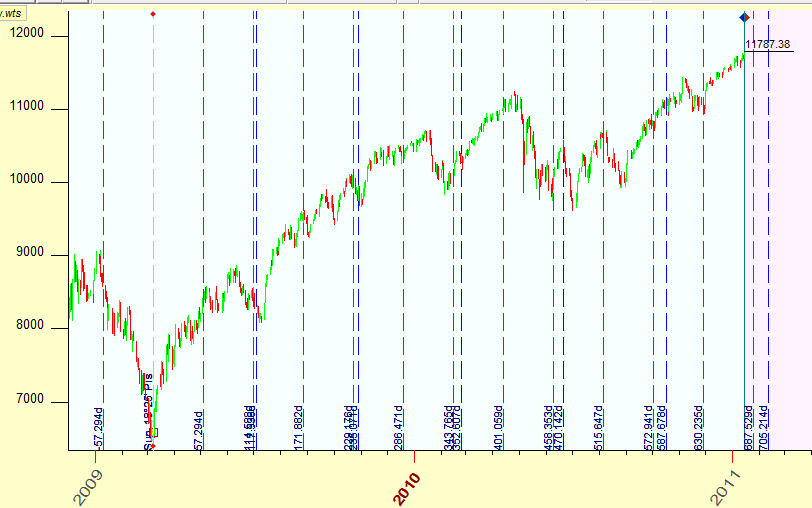
This is actually a spectrum analysis (math) in the clothes of clear intuitive charting tools like Fibonacci grid, Andrews pitchfork etc. I recommend to vary the starting point and try different patterns.
Now we will research astronomy based models. Interesting that trying to reveal the most informative angle separation we can apply exactly the same math techniques as we used for cyclic analysis. Look at the spectrogram calculated for Mars-Jupiter heliocentric angle separation:
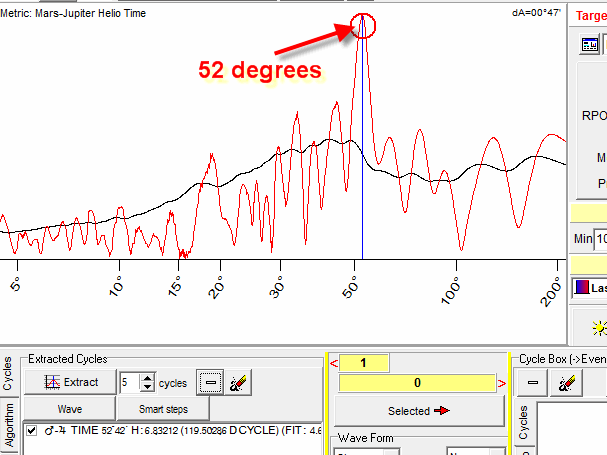
The peak of this diagram corresponds to 52 degrees angle, it means that this cycle/period/step is the most suitable for the cyclic analysis of the available data. And again, knowing the most informative angle separation we can use it for timing. This is Mars-Jupiter heliocentric equidistant lines with 52 degrees step:
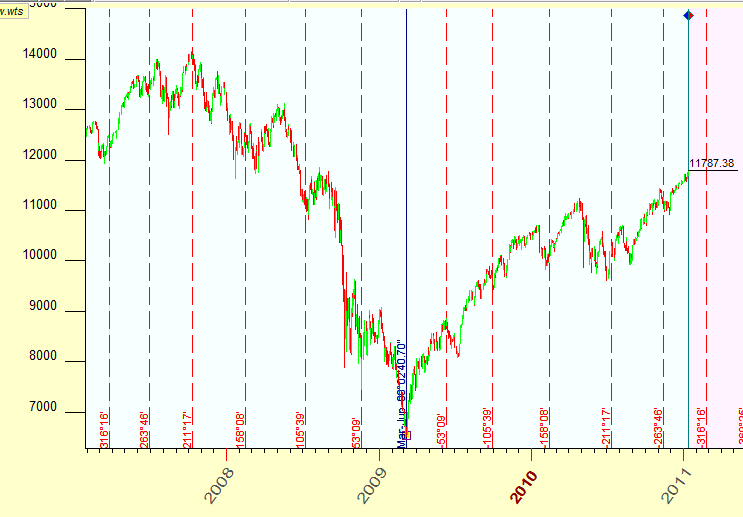
Here I picked up another strong cycle, 44 degrees, and draw 44 (blue) and 52 (red) degrees lines together:
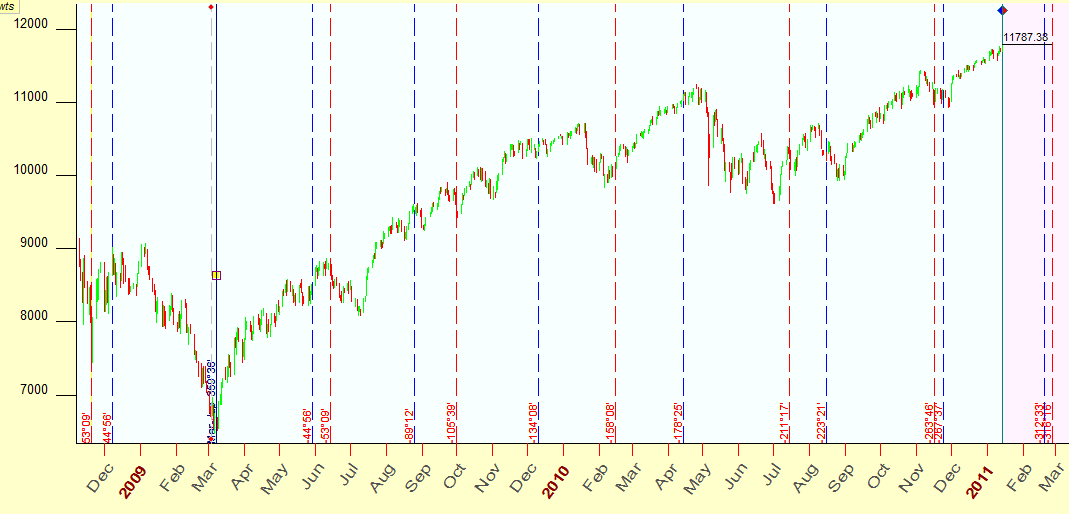
For practical usage I recommend to play with the most important astronomical cycles:
1) the Sun;
2) the Moon;
3) the Moon phases (the Moon - the Sun in Geo);
4) Mercury phases (Mercury - the Sun (=the Earth) in Helio);
5) Venus phases (Venus - the Sun Helio);
6) Mars phases (Mars - the Sun Helio).
Also try to use different starting points.
It looks like this method provides us a good combination of a formal approach (spectrum) and a non formal approach (charting tool). Spectrum module allows to reveal the periods of dominant cycles. This value is relatively stable, the period does not change fast. But when we try to generate a projection line based on this cycle, we need to calculate its phase i.e. the starting point of this cycle. This value is very unstable, the phase of the cycle can be changing a lot while the new price history is coming. So, a charting tool allows to vary a phase of analyzing cycle easier and faster and according to the fast-changing stock market weather, while Spectrum module reveals relatively stable values.
In this article I did not provide the impressive examples, and I did it with
purpose. There is no problem to find a good example; however, in real life such
examples cannot be used as a prove or disapprove of some theories. Before
applying any of good-looking models to your trading, more research is needed.
How to create "Smart steps" charting tool with Timing Solution
This is very easy, you calculate the spectrogram in a standard way, pick up the most important cycles clicking the mouse around the highest peaks
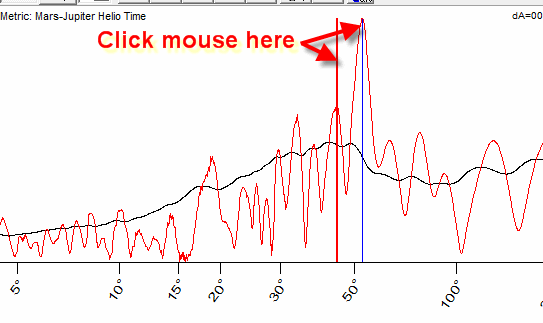
and click this button:

Now drag the mouse cursor to the starting pint you want to use. The program will draw equidistant lines that correspond to the chosen cycles automatically:
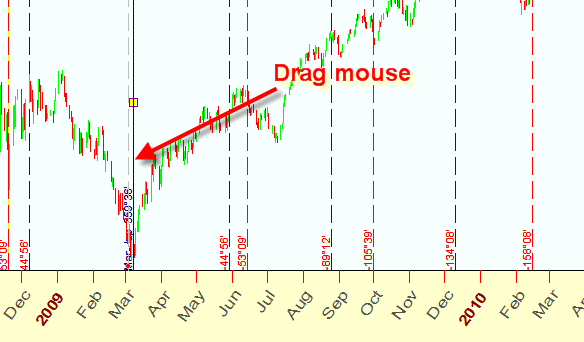
To calculate a spectrogram based on planetary angles follow these steps:
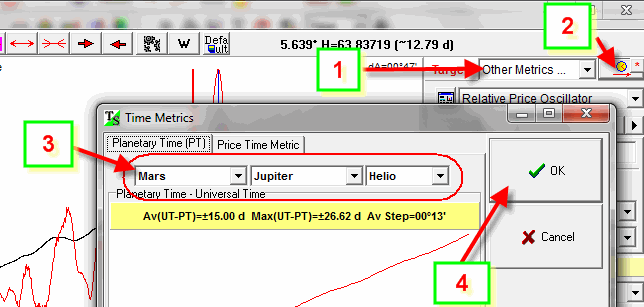
click "Smart steps" button and drag the mouse cursor.
Be sure that parameters of your spectrogram are set like these:
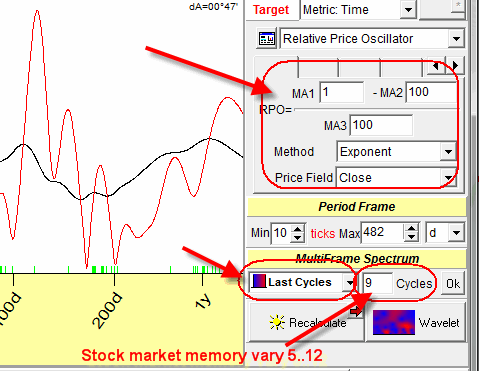
For the majority of financial instruments I recommend to vary the stock market memory parameter in a range of 5..12. This approach allows to reveal the latest dominant cycles.
For intraday chart it is better to use the bar metrics:
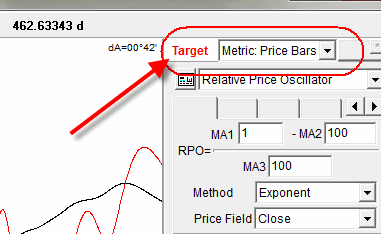
Regarding planetary combination that is most suitable for timing: I have no answer to this question. Maybe it makes sense to use planetary combinations that are confirmed by the standard cyclic analysis. I will show you one example. This is the spectrogram for DJI:
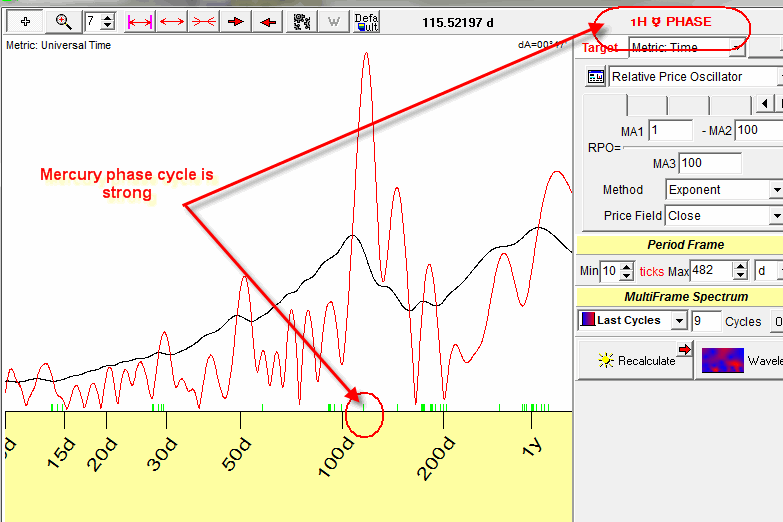
You see the peak here that correspond to 115-117 days cycle, the small lime stripes represent the average periods of the major astronomical cycles. While you move the mouse cursor over this diagram the program points you these cycles. Try to use this cycle.
BTW you can use this fast access button to choose Mercury phase metric (for example):
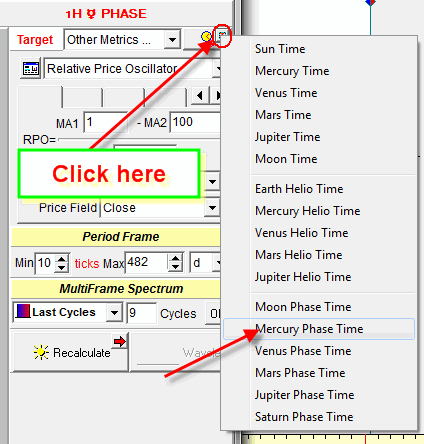
I recommend to select cycles one by one using for each cycle its own starting point. When you select all cycles, the starting point will be the same.
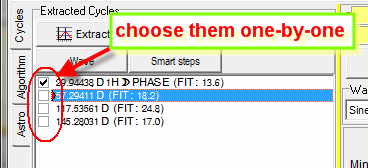
Do not use too many cycles, in most cases 1-4 cycles is enough.